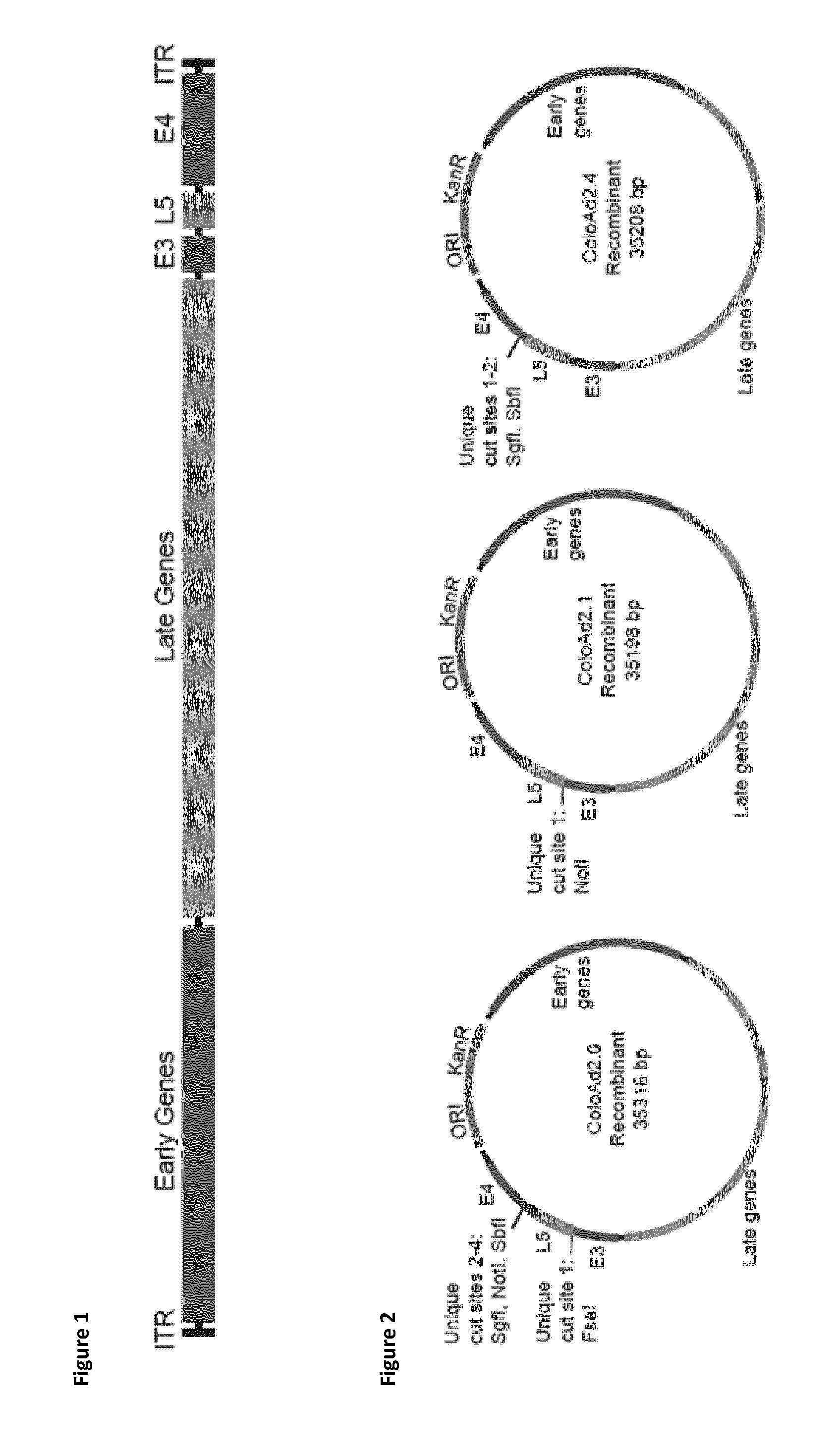A method of making adenovirus and corresponding plasmids
- Summary
- Abstract
- Description
- Claims
- Application Information
AI Technical Summary
Benefits of technology
Problems solved by technology
Method used
Image
Examples
example 1
Construction of the ColoAd1 Shuttle Vector
[0451]A 11978 bp shuttle vector, referred to as ‘ColoAd1 Shuttle Vector’, was constructed containing a p15A bacterial origin of replication, a Kanamycin resistance cassette and 5′ and 3′ arms of ColoAd1 joined by a PspOMI third restriction enzyme site (see FIG. 6).
[0452]Three DNA fragments were synthesised by PCR:[0453]1) a “5′ arm of ColoAd1” corresponding to the 5′ 4627 bp of ColoAd1 with a 5′ AscI restriction site and 3′ PspOMI restriction site,[0454]2) a “3′ arm of ColoAd1” corresponding to the 3′ 4482 bp of the ColoAd1 genome with a 5′ PspOMI restriction site and 3′ AscI restriction site, and[0455]3) a vector fragment containing a low copy p15A origin of replication and a kanamycin resistance cassette flanked by AscI restriction sites
[0456]PspOMI third restriction site in the 5′ arm and the 3′ arm was chosen as a suitable restriction site to allow the shuttle vector to be linearised and recombined with the ColoAd1 genome to form a plasm...
example 2
Construction of the ColoAd2.4 Shuttle Vector
[0483]The ColoAd1 shuttle vector generated in Example 1 contained 11 unique (native) restriction sites that occur only once in the genome allowing modification of any region of the ColoAd1 genome present in the shuttle vector (for example, modification of the E1 region). A restriction map showing the location of the sites and the ColoAd1 genes present in the shuttle vector is provided in FIG. 6.
[0484]Two of the unique (native) restriction sites (PspOMI and AclI) flank the fibre (L5) gene at positions 4634 and 6851 respectively in the ColoAd1 Shuttle Vector. These correspond to the original PspOMI and AclI that flank the fibre (L5) gene in the ColoAd1 genome at positions 27839 and 30065 (FIG. 9). In the ColoAd1 shuttle vector these sites permit DNA sequences in this region to be excised and replaced with a modified or different sequence, or have a DNA sequence inserted within them as a simple addition.
[0485]The ColoAd2.4 Shuttle vector was ...
example 3
Construction of the ColoAd2.0 Shuttle Vector
[0494]The ColoAd2.0 Shuttle Vector (SEQ ID NO: 15, FIG. 20) was generated from the ColoAd1 Shuttle Vector constructed in Example 1. The methods employed to generate the ColoAd2.0 Shuttle Vector were identical to those used to generate the ColoAd2.4 Shuttle Vector; using ligation of a synthetic DNA fragment between the PspOMI and AclI restriction sites detailed in Example 2
[0495]The synthetic DNA fragment sequence used to construct the ColoAd2.0 shuttle vector was similar to the sequence it was replacing in the ColoAd1 Shuttle Vector except it contained an additional 9 bp upstream of the Fibre (L5) gene, comprising a FseI original restriction site, and an additional 123 bp downstream of the fibre gene, comprising two polyadenylation sequences and SgfI, NotI and SbfI original restrictions sites (SEQ ID NO: 16, FIG. 21)
[0496]The construction of the ColoAd2.0 Shuttle Vector was confirmed by a panel of restriction digests with the enzymes FseI,...
PUM
| Property | Measurement | Unit |
|---|---|---|
| Temperature | aaaaa | aaaaa |
| Digital information | aaaaa | aaaaa |
| Digital information | aaaaa | aaaaa |
Abstract
Description
Claims
Application Information
 Login to View More
Login to View More - R&D
- Intellectual Property
- Life Sciences
- Materials
- Tech Scout
- Unparalleled Data Quality
- Higher Quality Content
- 60% Fewer Hallucinations
Browse by: Latest US Patents, China's latest patents, Technical Efficacy Thesaurus, Application Domain, Technology Topic, Popular Technical Reports.
© 2025 PatSnap. All rights reserved.Legal|Privacy policy|Modern Slavery Act Transparency Statement|Sitemap|About US| Contact US: help@patsnap.com



